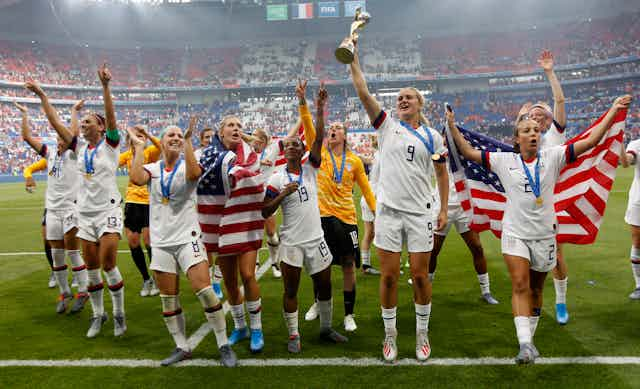The 2023 FIFA Women’s World Cup begins on July 20, 2023, in Australia and New Zealand, and the U.S. enters the soccer tournament in a familiar position: favorites.
The U.S. Women’s National Team, or USWNT, is the reigning back-to-back champion, and many pundits are expecting it to make history by securing a third successive title.
Certainly, the team is built on solid foundations – it has a tournament history like no other, having reached the podium in all eight editions of the tournament stretching back to 1991 – and lifted the winner’s trophy four times. And it still possesses some of the game’s most recognizable and decorated players, Megan Rapinoe and Alex Morgan among them.
Yet the U.S. players are not certain to win the World Cup this time around. No USWNT has experienced more turnover between World Cups than the current squad – it will be sporting a new head coach, and the team will be missing several mainstay players because of retirement and a spate of injuries. And its form heading into the tournament has been patchy.
Moreover, there are external currents that are also pushing against U.S. dominance. A commitment by governing body FIFA to growing the women’s game globally has contributed to nations around the world narrowing the gap with the U.S. on the pitch.
All of those factors should lead to a more competitive tournament in New Zealand and Australia. But having more teams challenging the U.S. is not the only yardstick for success in the women’s game.
As we argue in our forthcoming book, “The 2023 FIFA Women’s World Cup: Management, Politics and Representation,” much more needs to be done by world soccer’s governing body to put in place institutional reforms prioritizing what is right over simply what is profitable in the women’s game. We believe that only then can it play on a level playing field.
Moving the goal posts (in the right direction)
Some 22 years after the first official FIFA Women’s World Cup, the sport is witnessing dramatic growth internationally. The number of women and girls participating in the sport at all levels is increasing. FIFA’s plan is to double the number of women soccer players globally to 60 million by 2026 and pump US$1 billion into the women’s game over a four-year period.
Meanwhile, more and more countries are launching professional leagues, including recent additions such as Colombia and Mexico.
Accompanying this has been increased sponsorship of women’s clubs and leagues and a growing number of lucrative sponsorship deals for top players.
Governing bodies and franchises are beginning to invest more in players, coaches and infrastructure, too. And it has yielded success. The past year alone has seen record-breaking player transfers, record attendance at games and television viewing figures hitting an all-time high at both domestic and international levels.
This growth is not restricted to playing fields in Europe and North America. Women’s soccer in Africa, the Middle East and Asia has also benefited. For the first time, the World Cup will see 32 teams participate – up from 24 in the past two tournaments. Among the teams making their inaugural appearance will be Morocco, the Philippines, Vietnam and Zambia.
Noting the growth in such countries, U.S. coach Vlatko Andonovski commented: “The world that is catching up is Wales, is Vietnam, is Zambia, Portugal.”
That isn’t to say that a handful of countries led by the U.S. won’t again dominate. But even if they do, that would not negate the strides made in the women’s game since the last World Cup in 2019.
Leveling the playing pitch (a little)
Meanwhile, FIFA has displayed a commitment to investing, celebrating and marketing its flagship women’s tournament in ways not seen in previous editions. Prize money, team preparation cash and compensation to players’ clubs has increased 300% over the last World Cup, with the overall prize money standing at $152 million. Each player at the tournament will receive at least $30,000.
Yet the overall prize pool remains a fraction of the men’s equivalent – a gender disparity called out by Australia’s national women’s side in a recent video message.
And crediting FIFA for progress on gender pay issues ignores how women footballers had to overcome exploitation, under-marketing and structural and institutional barriers created in part by the game’s governing body in the first place.
Unlike the men’s game, dozens of players taking the pitch in Australia and New Zealand are amateur or semiprofessional footballers at best. Even some of those who are professional endure poor working conditions, insufficient facilities and unsafe playing conditions – something that likely plays a part in the recent spate of ACL injuries among top female players.
And this is to say nothing of the horrific and widespread cases of sexual misconduct, harassment and emotional abuse documented in the women’s game. Women soccer players from Afghanistan to India to Argentina have been subjected to systemic abuse, misconduct and violence stemming in part from labor precarity and a lack of workplace protections.
Here, the U.S. – long the global leader in the women’s game – is not immune, as a 2022 report into the sexual misconduct, and verbal and emotional abuse by coaches in the National Women’s Soccer League has shown.
Going into the 2023 World Cup, the USWNT remains a yardstick by which other teams can be measured. The U.S. players are emblematic of the soaring popularity and commercial value of women’s soccer. But as their labor activism, quest for equal pay and push for better protection reveals, even at the elite level of the women’s game, battles remain both on and off the pitch.

